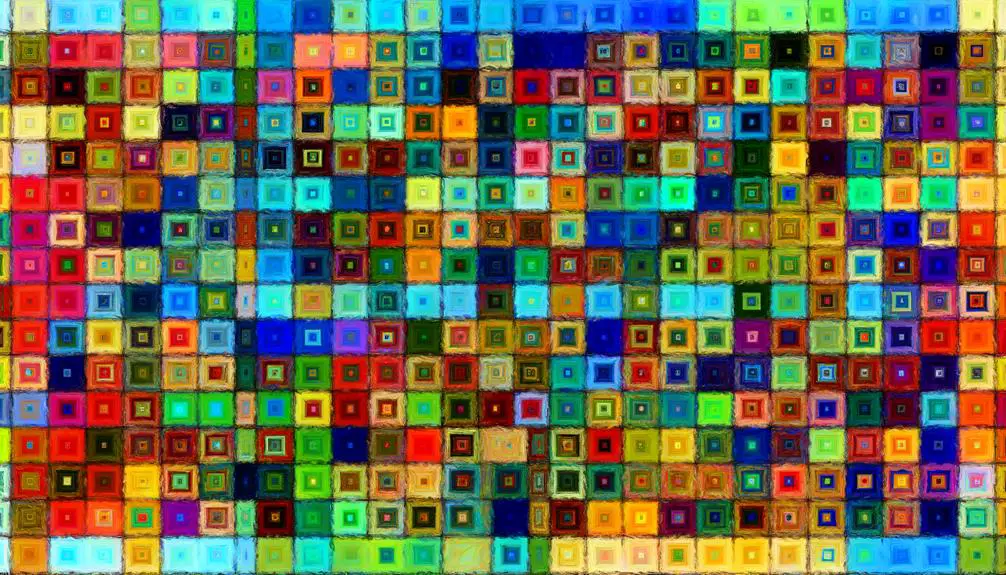Decoding the Meaning of a Square Inside a Square Symbol
The symbol of a square inside a square is rich in historical and cultural significance, symbolizing order, balance, and spatial organization. Its roots trace back to ancient Mesopotamia, China, and Egypt, where it represented Earth within the cosmos and provided protection.
Philosophically, it conveys the journey towards inner enlightenment and interconnectedness. Mathematically, it illustrates principles like the Pythagorean theorem and fractal geometry.
In art, it explores space, form, and cosmic balance, while in modern design, it embodies precision and clarity. Understanding this symbol opens doors to deeper insights on interconnectedness and balance.
Explore further to uncover its profound implications across various contexts.

Key Takeaways
- Represents order, balance, and spatial organization principles across various historical and cultural contexts.
- Symbolizes the interconnectedness and layered nature of existence in spiritual and philosophical interpretations.
- Demonstrates fundamental geometric properties like symmetry, proportion, and self-similarity.
- Used in modern art to explore geometric abstraction and challenge perceptions of space.
- Applied in architecture and data visualization for clarity, precision, and effective design communication.
Historical Origins
Tracing the historical origins of the square inside a square symbol reveals its profound significance across various ancient cultures and civilizations. Early manifestations can be observed in Mesopotamian artifacts, where it was employed in architectural schematics and urban planning, symbolizing order and balance.
Similarly, in ancient Chinese cosmology, the symbol delineated the earthly world from the celestial, encapsulating philosophical doctrines of harmony. Egyptian hieroglyphs also incorporated this motif to represent sacred spaces. This geometric figure transcended mere aesthetics, embodying fundamental principles of spatial organization and metaphysical beliefs.
Cultural Significance
In various cultures, the square inside a square symbol has been imbued with profound spiritual, philosophical, and societal meanings, reflecting diverse interpretations of order, unity, and transcendence.
In Chinese culture, it represents the Earth within the bounds of the cosmos, emphasizing harmony and balance.
In Islamic art, the motif illustrates the concept of infinity and the infinite nature of Allah.
Native American traditions often view it as a symbol of protection and sacred space, a microcosm within the macrocosm.
The juxtaposition of the inner and outer squares invites contemplation on the relationship between the individual and the collective, the mundane and the divine.
This symbol serves as a versatile metaphor for interconnectedness across various cultural narratives.
Spiritual Interpretations

Within the realm of spiritual interpretations, the square inside a square symbol often represents the journey toward inner enlightenment and the layered nature of existence.
This geometric emblem signifies the progressive deepening of understanding, where each inner square symbolizes a deeper layer of consciousness and self-realization.
The outer square reflects the material world, while the inner square embodies the spiritual core, suggesting a path from external distractions to inner peace.
This symbol encourages introspection, urging individuals to explore beneath surface appearances to uncover profound truths.
Such interpretations emphasize the interconnectedness of all life facets, illustrating how spiritual growth involves navigating through and harmonizing various layers of one's being.
Consequently, it serves as a contemplative tool for spiritual seekers.
Mathematical Perspectives
From a mathematical standpoint, the square inside a square symbol invites exploration of its geometric properties, such as symmetry, area ratios, and nested relationships.
This configuration also serves as an analytical tool for understanding fractals and recursive patterns, illustrating deeper symbolic interpretations.
Geometric Properties Explored
Examining the geometric properties of a square inscribed within another square reveals intriguing mathematical relationships and symmetry principles.
The inscribed square, rotated at a 45-degree angle relative to the outer square, intersects the midpoint of each side of the outer square. This configuration demonstrates the Pythagorean theorem, as the diagonal of the inner square equals the side length of the outer square.
Moreover, the ratio between the areas of the inner and outer squares is 1:2, providing elegant insight into scale and proportion. Such geometric arrangements highlight the inherent symmetry and balance in mathematical forms, offering a visually compelling illustration of fundamental geometric principles that underlie more complex mathematical concepts.
Symbolic Interpretations Analyzed
In mathematical contexts, the symbol of a square inscribed within another square often represents the concept of recursive structures and self-similarity. This imagery is closely tied to fractal geometry, where patterns repeat at progressively smaller scales.
The nested squares epitomize the notion that complex forms can arise from simple, repeated processes. Additionally, such configurations embody symmetry and equilibrium, illustrating foundational principles in both Euclidean and non-Euclidean geometries.
On an algebraic level, this nested structure can symbolize nested functions or iterative algorithms, embodying the essence of computational processes. This visual metaphor therefore serves as a bridge between abstract mathematical theories and tangible geometric interpretations, enriching our understanding of both disciplines through its layered simplicity.
Artistic Representations

In the domain of artistic representations, the motif of a square within a square often manifests in modern art as a powerful abstraction that challenges perceptions of space and form.
This geometric arrangement not only serves as a vehicle for exploring spatial relationships but also resonates with deeper cultural symbolism, reflecting ideas of containment, harmony, and duality.
Analyzing these artistic interpretations reveals how such a simple configuration can convey complex and multifaceted narratives.
Modern Art Interpretations
While the motif of a square inside a square may appear deceptively simple, modern art interpretations often reveal a profound exploration of spatial relationships, geometric abstraction, and the viewer's perception of form and color.
Artists like Josef Albers have famously employed this motif in works such as his 'Homage to the Square' series, where varying hues and arrangements challenge the observer's visual and emotional response. The nested squares create a dynamic interplay of foreground and background, inviting contemplation of symmetry and balance.
Additionally, this motif allows artists to interrogate the boundaries between two-dimensional and three-dimensional spaces, prompting viewers to reconsider their assumptions about depth and flatness.
Consequently, the square inside a square transcends mere geometry to become a versatile tool in modern artistic expressions.
Cultural Symbolism Usage
The motif of a square inside a square, beyond its aesthetic appeal, serves as a potent cultural symbol, reflecting diverse meanings across various artistic traditions and historical contexts. This geometric configuration transcends mere form, often embodying profound philosophical and spiritual concepts.
In cultural symbolism, it can represent:
- Integrative Harmony: The unity of disparate elements into a coherent whole.
- Sacred Geometry: A manifestation of divine order and cosmic balance.
- Protection and Containment: The outer square as a guardian of the inner sanctum.
- Duality and Balance: The interplay between the internal and external worlds.
These interpretations reveal the motif's enduring resonance, inviting contemplation and deeper understanding of humanity's quest for meaning through art.
Modern Applications
Today, the square inside a square symbol finds relevance in various modern applications ranging from digital design to architectural blueprints, symbolizing layers of complexity and depth. This geometric figure is often employed to illustrate nested structures and hierarchies, enhancing both functional design and aesthetic appeal.
| Application Area | Usage Example | Symbolic Meaning |
|---|---|---|
| Digital Design | User Interface (UI) Elements | Complexity and nested systems |
| Architecture | Building Layouts | Structural integrity and hierarchy |
| Data Visualization | Nested Data Sets Representation | Depth in information layers |
In digital design, it clarifies user experiences by demarcating interactive zones. Architects use it to represent different layers of building plans, ensuring clarity of structure. In data visualization, it elucidates complex datasets, making them digestible. Consequently, the symbol serves as a versatile tool in contemporary contexts.
Conclusion
The symbol of a square inside a square encapsulates a rich tapestry of meanings spanning historical origins, cultural significance, spiritual interpretations, mathematical perspectives, artistic representations, and modern applications.
It bridges ancient civilizations with contemporary societies, intertwines spirituality with geometry, and merges artistic expression with mathematical elegance.
This multifaceted symbol continues to captivate, offering a profound lens through which to explore human understanding, cultural evolution, and the intricate patterns that shape perceptions of the world.






